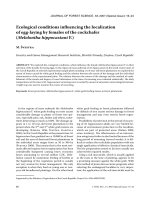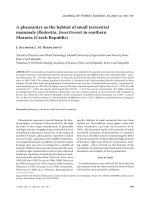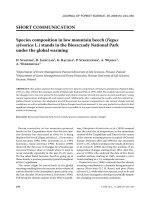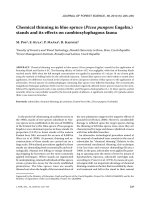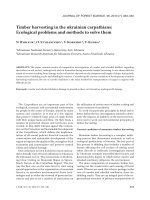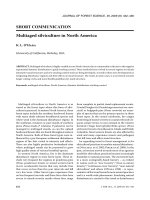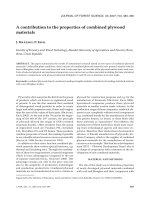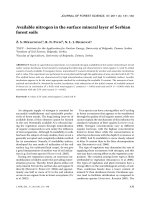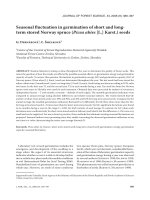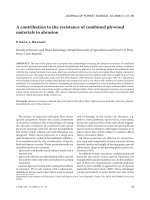Báo cáo lâm nghiệp: "Available nitrogen in the surface mineral layer of Serbian forest soils" docx
Bạn đang xem bản rút gọn của tài liệu. Xem và tải ngay bản đầy đủ của tài liệu tại đây (315.53 KB, 10 trang )
J. FOR. SCI., 57, 2011 (4): 131–140 131
An adequate supply of nitrogen is essential for
successful establishment and sustainable produc-
tivity of forest stands. e long lasting reserves of
available forms of this element cannot be formed
in the soil. Potentially available N is released dur-
ing the vegetation season through mineralization
of organic compounds in soil, under the infl uence
of microorganisms. Although N availability in soils
has been the subject of many studies, there is not a
generally accepted and completely reliable method
for its assessment. Namely, N availability indices,
developed for one mode of utilization of the soil
surface (e.g. for cultivated land crops), do not give
a good interpretation of another way of soil utiliza-
tion (e.g. for forest species) (S et al. 2005).
During one vegetation season, an enormous im-
mobilization is hidden under the prevailing miner-
alization process. ereby, forest plants utilize not
only mineral N from the soil but also soil organic N
directly (B, P 2004) and approxi-
mately one half or more of N in the soil solution
occurs in an organic form in forest ecosystems (Y
et al. 2002).
Tree species can have a strong eff ect on N cycling
in forest ecosystems that appears to be manifested
through the quality of soil organic matter, while one
cannot explain the mechanisms of this infl uence by
standard evaluation of litter quality (L et al.
2004). Nitrogen concentrations vary in diff erent
organic horizons, with the highest concentration
found in forest litter, while the concentrations in
other layers decrease with the depth (L et
al. 2000). Soil N availability is more closely related
to litter N content than to the litter decomposition
rate (J et al. 2006).
e type of vegetation may determine the rate of
supplying these ecosystems with nitrogen, and this
rate may have a strong eff ect on the vegetation com-
position. e variation among forest types is likely
attributable to vegetation (J et al. 2006).
e types of vegetation and plant remnants have a
strong eff ect on the microbiological activity of soil.
us, coniferous forests have a lower content of
mineral N than deciduous forests. Deciduous spe-
cies tend to facilitate nitrifi cation as compared to
coniferous species (A, R 2001). e
JOURNAL OF FOREST SCIENCE, 57, 2011 (4): 131–140
Available nitrogen in the surface mineral layer of Serbian
forest soils
Ž. S. D
1
, R. N. P
2
, N. L. J. D
1
INEP ‒ Institute for the Application for Nuclear Energy, University of Belgrade, Zemun, Serbia
2
Institute of Soil Science, Belgrade, Serbia
3
Faculty of Agriculture, University of Belgrade, Zemun, Serbia
ABSTRACT: Based on a greenhouse experiment, we evaluated nitrogen availability in the surface mineral layer of soil
under various deciduous forest stands by analysing the following soil characteristics: total organic C, total N, initial
content of easily available N inorganic forms, mineralized N content obtained by aerobic and anaerobic incubations
and A-value. The experiment was performed on a test plant and through the application of urea enriched with 5.4%
15
N.
The studied forest soils are characterized by high mineralization intensity and high N availability indices. Aerobic
incubation appears to be the most appropriate method for evaluating the available N content. The amounts of min-
eralized and nitrified N, obtained by aerobic incubation, with subtraction of the initial content of available mineral
N forms are in correlation (P ≤ 0.05) with total organic C content (r = 0.916) and total soil N (r = 0.903) while the
correlation with the C/N ratio is poor (r = 0.645).
Keywords: A-value; C/N ratio; total organic C; total soil N
132 J. FOR. SCI., 57, 2011 (4): 131–140
species identity in plant communities may also di-
rectly infl uence N mineralization and nitrifi cation
through specifi c compounds in their leaf litter, such
as pine polyphenols (H, V
2000) or root exudates (S et al. 2007).
On the other hand, forest clear-cutting disrupts
the existing balance of the soil organic matter con-
tent. By clear-cutting, stopping N uptake by trees
and decreasing total deposition, N availability in
the soil is increased (J et al. 2004). Also, sub-
stituting the old coppice for young stands favours
the nitrifying community (Z et al. 2007). Mi-
crobial immobilization, favoured by organic matter
input and temperature increase, was probably the
cause of a decrease in the net mineralization of N
(J et al. 2004).
Obviously, the quantity of available N in soil is an
important ecological factor. e aim of our study,
apart from the assessment of available soil N in the
surface mineral layer of various types of forest soils,
was to establish the relationship between available
N reserves and some agrochemical characteristics
of forest soils. We shall there by contribute to the
information on N availability in various forest soils
of the temperate climatic zone of Europe, useful for
understanding nitrogen dynamics, necessary for
the corresponding and adequate forestry practice.
is is to be achieved by determining the quanti-
ty of available N at the beginning of growing sea-
son; evaluating potentially available N by diff erent
methods; determining nitrogen absorbed by the
experimental crop.
MATERIAL AND METHODS
Sites and soils used in the experiment
For this study we collected 5 soil samples from
4 locations in Serbia, Southeast Europe (Table 1).
e forest stands were more than 25 years old.
Soil samples were collected in mid-March from
the surface mineral portion of the soil layer, from
a depth of 0–20 cm. During the sample collection,
remnants of forest litter, fallen leaves, fl attened
grass, tree and shrub branches, mosses, etc., were
removed. We used the collected soil samples to es-
tablish the vegetation experiment and laboratory
testing. All research results relate to the features of
the so-called fi ne soil, so that they are comparable
with other authors’ results. For the determination
of agrochemical features and available N, soil sam-
ples were air dried ground and sieved through a
2 mm-sieve.
Experimental design
We used the A-value method for a greenhouse
experiment with test plant and application of
N-fertilizers labelled with the stable N isotope (
15
N).
In our research we employed the A-value method
according to the description given by F and
D (1952). According to F and B
(1974), the magnitude of the “А” value, indicating
the reserve of nitrogen available to plants, does not
depend on the dosage of fertilizer; this is a constant
value and the nitrogen fertilizer does not have an
eff ect on an increase in the nitrogen mineralization
rate in soil. e A-value concept is based on the as-
sumption that major soil elements are absorbed by
plants, proportionately to the content of their avail-
able forms in the soil. Knowing the dosage of fertil-
izer applied to the soil and the amount of marked
nutrient absorbed by plants, one can determine the
value of available nitrogen in the soil (F, D
1952):
c
sc
T
TU
A
×
=
(1)
where:
А – amount of available nitrogen in the soil (kg·hа
–1
);
T
s
– amount of applied fertilizer;
T
c
– amount of nitrogen absorbed from fertilizer in the
aboveground part of a plant;
U
c
– amount of nitrogen absorbed from the soil in the
aboveground part of a plant.
For the purpose of the greenhouse experiment, air-
dried soil was manually crumbled and the required
quantity was weighed (2 kg of soil per pot). Urea,
(NH
2
)
2
CO, was applied, enriched with 5.4%
15
N.
It was applied at the concentration of 50 mg N kg
–1
soil. Along with urea, 153.4 mg of KH
2
PO
4
and
49.8mg of K
2
SO
4
were applied (the ratio of the ap-
plied macronutrients, N:P
2
O
5
:K
2
O, was 1.0:0.8:0.8).
e fertilizers were uniformly applied in the form
of a solution before fi lling the pots with soil. e
experiment was carried out in three replications.
e experimental crop was oat (Avena sativa L.,
cv. Kondor). is crop was used for the determi-
nation of the A value for two reasons. Firstly, con-
trary to tree species, oat does not manifest any
15
N
discrimination during uptake, distributing it evenly
across the plant organs. Secondly, soils have a wide
range of physicochemical characteristics, above
all the pH range (Table 1), that makes the devel-
opment of oat possible, but could compromise the
growth of other test species.
In each pot, 13 oat seeds were sown. After 7 days,
the number of plants was reduced to 10. Soil hu-
J. FOR. SCI., 57, 2011 (4): 131–140 133
midity in vegetation pots was maintained at ap-
proximately 0.6–0.8 of maximum water holding
capacity for each soil type. Two months after ger-
mination, the experiment was terminated. Above-
ground parts of the crop (straw) were separated
from roots and analysed separately. e roots were
carefully separated from soil. According to the rec-
ommendations of IAEA for plant material prepa-
rations for isotope analyses (A et al. 1990),
the plant material was dried in oven for 18–24 h at
70°C, until constant mass was achieved. e mate-
rial was ground subsequently.
Analytical methods and methods
of nitrogen availability evaluation
pH values were determined in 1M KCl (1:2.5w/v).
We determined the total amount of organic C us-
ing the procedure described by N (1972):
heating of soil samples with a chromium-sulphuric
mixture and spectrophotometric measurement of
optical densities. Total N in soil and plant samples
was determined by semi-micro Kjeldahl digestion
(B, M 1982).
e content of easily available N forms in soil
was determined after extraction with 2M KCl
(1:10ratio) and 30 min shaking using a procedure
described by K and N (1982). e sus-
pensions were fi ltered through Whatman 42 fi lter
paper, and NH
4
+
-N and NO
3
–
-N concentrations were
determined by steam distillation, with the addition
of MgO and Devarda’s alloy, and the released NH
3
was collected in an indicator solution of H
3
BO
3
.
e concentrations of NH
4
+
-N and NO
3
–
-N were de-
termined by titration with standard H
2
SO
4
.
Quantities of available N, produced in soil under
aerobic and anaerobic conditions, were determined
according to the procedures described by K
and B (1966). e intensity of miner-
alization (IM) was calculated from the following
formula:
IM =
total
initialmin
–
N
NN
(2)
where:
N
min
‒ quantity of mineralized N without subtraction of
the initial content of available mineral N (for the
anaerobic incubation of NH
4
+
-N content);
N
initial
‒ initial content of available mineral N (for the
anaerobic incubation of NH
4
+
-N content);
N
total
– total content of N in soil.
e nitrogen availability indices (ANI) were calculated
from the following formula:
ANI =
initial
initial
–
min
N
NN
(3)
where:
N
min
– quantity of mineralized N without subtraction of
the initial content of available mineral N (for the
anaerobic incubation of NH
4
+
-N content);
N
initial
‒ initial content of available mineral N (for the
anaerobic incubation of NH
4
+
-N content).
Table 1. Soils utilized in the experiment and their textural composition
Soil type (by FAO
soil classifi cation)
Location, average
annual temperature,
average annual
rainfall
Main tree species
Granulometric composition (%)
pH in
1M KCl
sand
0.02–2.0 mm
silt
0.002–0.02 mm
clay
< 0.002 mm
Chernozem, formed
on loess,
carbonated, deeply
Zemun
11.7°C
669 mm
Acer pseudoplatanus L.
Alnus glutinosa Gaertn.
36.5 31.2 32.3 7.1
Eutric cambisol,
formed on lake
sediments, lessived
Ralja
10.7°C
649 mm
Quercus robur L.,
Quercus frainetto Tenore,
Alnus incana Moench.,
Acer campestre L.
38.7 33.8 27.5 3.8
Calcaric cambisol,
typical, shallow
Bileća
12.2°C
1,620 mm
Quercus pubescens Willd. 36.9 27.3 35.8 5.2
Eutric fl uvisol,
carbonated, deeply
Obrenovac
11.0°C
662 mm
Robinia pseudoacacia L.
Fraxinus excelsior L.
52.5
23.4
19.6
39.5
27.9
37.1
6.6
6.8
134 J. FOR. SCI., 57, 2011 (4): 131–140
Determination of isotope-labelled
nitrogen in the experimental crop
Isotope measurements (
14
N:
15
N) of the plant ma-
terial were performed in two replications in full
compliance with IAEA methodologies (A
et al. 1990; C et al. 1990): conversion of sam-
ple nitrogen into the ammonium form by an oxida-
tion-reduction reaction, further converting of NH
3
into N
2
by the reaction with alkaline hypo-bromide
and subsequent measurement on a CEC 21-620-A
California mass spectrometer (Consolidated En-
gineering Corporation, Pasadena, California). For
the nitrite and nitrate nitrogen forms, the classic
procedure involves the reduction to NH
3
by Devar-
da’s alloy during steam distillation, after previous
removal of NH
3
present in the same sample by alka-
line distillation with MgO (C et al. 1990). Clas-
sic equipment for the process of N
2
preparation
for the mass spectrometer includes a system based
on degassing of liquid samples under vacuum and
their subsequent mixing in Rittenberg Y-tubes.
Statistical analysis
Statistical analysis of parameters necessary for
N availability assessment included calculations of
standard deviation (SD), correlation coeffi cient (r)
and the test of statistical signifi cance of correlation
coeffi cients by Student’s test.
RESULTS
Vegetation experiment in pots
e experimental crop is characterized by great
variations in aboveground mass (straw mass) and
root mass (Table 2). e ratio of the biomass of the
aboveground part to the biomass of roots of the ex-
perimental crop on Fluvisol under the black locust
forest is the highest (6.58), namely, a considerably
larger aboveground part of the experimental crop
was formed on this soil compared to the roots. is
ratio is in the range from 4.37 to 4.88 in the experi-
mental crop on other soils. On Eutric Cambisol, the
crop reaches the highest straw and root masses. e
concentration of nitrogen in the experimental crop
varies within a very wide range (Table 2). e low-
est values are found in oats grown on Chernozem,
and the highest on Calcaric Cambisol and Fluvisol.
e aboveground part of oats on Calcaric Cambi-
sol and Fluvisol is richer in nitrogen by 35–55%
than the root part, while on Chernozem and Eutric
Cambisol, the percentage of nitrogen in the straw is
approximately equal to that in the roots. e high-
est uptake of nitrogen by the experimental crop
was observed on Eutric Cambisol (200.47 mg of N
per pot) and the lowest on Chernozem (127.80 mg
of N per pot).
Inorganic forms of N availability in soil
e total content of C and N in the examined soils
(Table 3) is in the range of these values 1.94–7.60%
and 0.181–0.594%, respectively. e values of the
С/N ratio are in the range of 10.31–12.79, which
is usual for forest soils. Except the soil under the
black locust forest, the ammonium form of nitro-
gen is the dominant form of easily available miner-
alN. e highest amounts of NH
4
+
–N and available
mineral N are found in Eutric Cambisol, where the
ratio of mineral N to total N is the highest (2.67%).
In the investigated Calcaric Cambisol the highest
amounts of mineralized and nitrifi ed N were ob-
tained by aerobic incubation (Table 3). Due to this,
the mineralization intensity (IM) and N availability
index (ANI) are the highest in this soil (1.576 and
2.710, respectively), while in the other investigated
soils they are signifi cantly lower. In Chernozem and
Fluvisol, the highest quantities of NO
3
–
-N were ob-
tained by aerobic incubation. However, a very small
amount of mineralized and nitrifi ed N is obtained
by aerobic incubation in the soil under the black
locust (only 0.40 mg N·kg
–1
soil), and both IM and
ANI values are nearly zero.
A slightly smaller N quantity (Table 3) was min-
eralized by anaerobic incubation in Calcaric Cam-
bisol. However, in the other investigated soils the
quantities of mineralized N by anaerobic incu-
bation were even up to 10 times higher than the
quantities of N obtained by aerobic incubation.
Especially high amounts of mineralized N (imply-
ing also high values of IM and ANI) were obtained
in Fluvisol, both under black locust and ash forests
(Table 3).
Nitrogen availability determined
by the A-value method
In the experimental crop grown on Calcaric Cam-
bisol, the lowest values of nitrogen fraction were
obtained (Table 4) in fertilizer-derived fraction
(N
dff
), only 18.48 mg of N/pot; and the highest val-
ues were determined in nitrogen fraction derived
J. FOR. SCI., 57, 2011 (4): 131–140 135
from soil (N
dfѕ
): 172.02 mg of N/pot. In the experi-
mental crop on the other investigated soil types,
the values of this nitrogen fraction are practically
twice higher, which shows that the percentage of
fertilizer nitrogen utilization varies between 30.6%
and 39.4%. On the other hand, the experimental
Table 2. Parameters of plant yield and N content in the experimental crop
Soils Plant part
Concentration of nitrogen
(%)
Crop dry mass
(g per pot)
N uptake
(mg N per pot)
Chernozem
straw
root
total
straw/root ratio
0.702 ± 0.049
0.771 ± 0.045
–
–
14.72 ± 1.55
3.26 ± 0.85
17.98 ± 2.37
4.51
102.91 ± 8.40
24.89 ± 5.39
127.80 ± 12.47
–
Eutric cambisol
straw
root
total
straw/root ratio
0.944 ± 0.102
0.878 ± 0.018
–
–
17.83 ± 0.31
3.65 ± 0.94
21.48 ± 1.20
4.88
168.41 ± 19.08
32.06 ± 8.47
200.47 ± 26.18
–
Calcaric cambisol
straw
root
total
straw/root ratio
1.700 ± 0.081
1.196 ± 0.088
–
–
9.65 ± 0.32
2.21 ± 0.15
11.86 ± 0.47
4.37
164.07 ± 13.05
26.43 ± 2.30
190.50 ± 15.00
–
Fluvisol (b. locust)
straw
root
total
straw/root ratio
1.595 ± 0.124
1.189 ± 0.092
–
–
10.24 ± 1.89
1.56 ± 0.27
11.80 ± 2.15
6.58
163.36 ± 16.46
18.52 ± 3.65
181.88 ± 20.00
–
Fluvisol (ash)
straw
root
total
straw/root ratio
1.729 ± 0.062
1.111 ± 0.016
–
–
9.47 ± 0.93
2.09 ± 0.47
11.56 ± 1.37
4.52
163.81 ± 18.74
23.21 ± 4.96
187.02 ± 23.60
–
Table 3. Total organic C, total N and easily available mineral N in soil
Chernozem Eutric cambisol Calcaric cambisol Fluvisol (b. locust) Fluvisol (ash)
Total organic C (%) 1.940 2.240 7.600 3.240 2.960
Total N (%) 0.188 0.181 0.594 0.284 0.273
C/N ratio 10.310 12.400 12.790 11.410 10.840
Initial content available mineral N (mg N·kg
–1
of soil)
NH
4
+
-N 23.100 29.050 25.550 13.650 15.510
NО
3
–
-N 8.400 19.250 8.920 14.180 8.720
(NH
4
+
+ NО
3
–
)-N 31.500 48.300 34.470 27.830 24.230
Obtain of aerobic incubation
NH
4
+
-N 20.300 58.800 120.800 8.800 35.000
NО
3
–
-N 22.800 10.300 7.100 19.400 19.500
Σ (NH
4
+
+ NО
3
–
)-N 43.100 69.300 127.900 28.200 54.500
IM 0.617 1.160 1.573 0.013 1.109
ANI 0.368 0.435 2.710 0.013 1.249
Obtain of anaerobic incubation
NH
4
+
-N 111.700 193.400 109.200 281.000 301.500
IM 4.713 9.080 1.408 9.414 10.476
ANI 3.835 5.657 3.274 19.586 18.439
IM – mineralization intensity, ANI – N availability index
136 J. FOR. SCI., 57, 2011 (4): 131–140
crop on Chernozem is characterized by the lowest
soil-derived nitrogen fraction (90.9 mg N per pot),
in comparison with the amounts found in crops
on the other investigated soils (between 147.6 and
172.0 mg N per pot). us, the lowest ratio of N
fraction derived from soil (N
dfs
) is found in the ex-
perimental crop on Chernozem (71.2%) and the
highest on Calcaric Cambisol (90.3%). Accordingly,
the obtained A-values (the amount of available N
in the soil) are the highest in Calcaric Cambisol
(440.82 mg of N per kg of soil) and the lowest in
Chernozem (only 117.56 mg of N per kg of soil).
DISCUSSION
Soil pH and agrochemical parameters
of nitrogen availability
S-M and P (1999) suggested that pH is
an important regulator of net nitrifi cation in forest
soils. An increase of pH in forest fl oor has a positive
eff ect on net nitrifi cation, while the acidifi cation pro-
vokes a decrease. Net nitrate production in organic
horizons is positively related to soil pH and negatively
related to the C/N ratio (P et al. 2000). Net
nitrifi cation in forest fl oor is not found at pH values
below 4.5 (S-M, P 1999). Eutric Cam-
bisol is characterized by low pH, approaching the
boundary values (Table 1). However, data presented
in Tables 3 and 4 show that the amount of available
N is higher in Eutric Cambisol than in Chernozem,
which is characterized by neutral pH. In addition, it
is interesting that the pH value correlates adversely
with the content of easily available mineral N forms
in soil (P ≤ 0.05; r = –0.909). Evidently, the eff ect
of pH on the mineralization of nitrogen in the sur-
face mineral layer of forest soils is diff erent from
that in the forest fl oor. Besides, total crop and straw
masses are in high correlation with the percentage
of easily available mineral N in total soil nitrogen
(P ≤ 0.01; r = 0.968 and 0.978, respectively), while their
correlations with N concentration in straw are nega-
tive (P ≤ 0.05; r = –0.892 and –0.886, respectively).
e soil under the vegetation cover consisting
of grown-up trees contains a substantial quantity
of organic matter derived from vegetation waste,
fallen from the trees or from root metabolism
products. Due to such, chronically high N depo-
sition, the C/N ratio is narrowed in many forest
ecosystems (M, M 2002). In the in-
vestigated soils the contents of total organic C and
total N show a highly signifi cant mutual correlation
(P ≤ 0.01; r = 0.996), while the correlation with
yield parameters is weak or nonexistent. ere is
no correlation between the C/N ratio and yield
parameters.
Contrary to the process of nitrifi cation favoured
in arable soils of fi elds, the NH
4
+
form is highly
prevalent in forest soils (L et al. 2000).
Ammonium can be oxidized to nitrate (NO
3
) by
chemoautotrophic bacteria using CO
2
as a carbon
source, or by heterotrophs using organic matter as
C and N sources (D B, K 2001). Low
Table 4. Amounts of nitrogen fractions originating from the fertilizer (N
dff
) and soil (N
dfs
) in the experimental crop
(mg N per pot) and the obtained A-values in the investigated soils (± SD)
Parameters Chernozem Eutric cambisol Calcaric cambisol Fluvisol (b. locust) Fluvisol (ash)
N
dff
In straw (T
c
) 30.71 ± 2.50 33.25 ± 3.67 16.71 ± 1.81 32.24 ± 3.63 27.52 ± 5.60
In root (T
r
) 6.16 ± 0.32 6.14 ± 0.68 1.77 ± 0.10 2.06 ± 0.92 3.09
Total (T
c
+ T
r
) 36.87 39.39 18.48 34.29 30.61
N
dfs
In straw (U
c
) 72.20 ± 6.03 135.16 ± 15.42 147.36 ± 11.36 131.13 ± 13.25 136.29 ± 13.48
In root (U
r
) 18.73 ± 5.28 25.92 ± 8.99 24.66 ± 2.19 16.46 ± 4.38 20.12
Total (U
c
+ U
r
) 90.93 161.08 172.02 147.59 156.41
% fraction of N
in the derived from soil
71.20 80.30 90.30 81.10 83.60
A-value (mg N·kg
–1
soil) 117.56 ± 3.85 203.23 ± 1.05 440.82 ± 20.67 203.38 ± 17.71 247.61 ± 34.97
T
c
– amount of nitrogen absorbed from fertilizer in the aboveground part of a plant, T
r
– amount of nitrogen absorbed
from fertilizer to the root of plants, U
c
– amount of nitrogen absorbed from the soil in the aboveground part of a plant,
U
r
– amount of nitrogen absorbed from the soil to the root of plants.
J. FOR. SCI., 57, 2011 (4): 131–140 137
NO
3
–
concentrations found in forest soils are a fre-
quent characteristic of low nitrifi cation rates (Z-
et al. 2007). We have found that the sum of eas-
ily available nitrogen forms, Σ(NH
4
+
-N + NO
3
–
-N),
is in a better correlation with the analyzed param-
eters. Individually, the contents of NH
4
+
-N and
NO
3
–
-N in the investigated soils are in poor corre-
lation with yield parameters, pH values or actual
properties.
Nitrogen availability indices obtained
by incubation methods
By aerobic incubation we obtained relatively
small quantities of NO
3
–
-N in the examined soils
(Table 4). ere are diff erent mechanisms that may
limit net nitrifi cation in forest soils. Moreover, soil
moisture and temperature are the most impor-
tant factors infl uencing the overall mineralization
rate (P, A 1998). Nitrifi cation potential
and nitrate production at fi eld water capacity and
25°C are the highest in forest litter, while they are
scarcely detectable in the mineral component of
soil (L et al. 2000) from which our sam-
ples were taken. In the mineral horizon, the limita-
tion of net nitrifi cation in soils with high C/N ratio
probably resulted from low gross NH
4
+
production
(C et al. 2009).
Investigations based on the isotope dilution method
showed that many ecosystems, including coniferous
forests and old forests with low to negative net nitri-
fi cation rates, have high total nitrate production, ac-
companied by rapid microbial immobilization (Z-
et al. 2007). M and M (2002) found
out that N mineralization in the surface horizon of
forest soil was not aff ected by the C/N ratio. However,
G et al. (1998) reported a negative correla-
tion between the net nitrifi cation rate and C/N ratio
in forest fl oor. C et al. (2009) also ob-
served a signifi cant negative relationship between net
nitrifi cation and the C/N ratio of soil in both organic
and mineral horizons. Net nitrifi cation and nitrate
leaching show a strong inverse relationship with the
C/N ratio of soil (G et al. 1998; L
et al. 2004). As a consequence of this empirical rela-
tionship, soil C/N has been proposed as a criterion to
evaluate the susceptibility of a site to N saturation and
nitrate leaching (MD et al. 2002). ereby,
the mechanism of the relationship between C/N ratio
in soil and net nitrifi cation or nitrate leaching is not
clear (C et al. 2009).
We found out that the amounts of mineralized
and nitrifi ed N obtained by aerobic incubation and
the corresponding mineralization rates are not in
correlation either with biological parameters of
plant yield or with N percentage and N fraction
absorbed by the crop. pH values were correlated
neither with the amount of mineralized and nitri-
fi ed N obtained by aerobic incubation nor with the
corresponding values of IM and ANI. However, the
amounts of mineralized and nitrifi ed N obtained
by aerobic incubation with subtraction of the ini-
tial content of available mineral N forms are in
correlation (P ≤ 0.05) with total organic C content
(r = 0.916) and total soil N (r = 0.903) while the cor-
relation with the C/N ratio is poor (r = 0.645).
Total amount of mineralized N is always higher
under anaerobic conditions, while immobilization
is higher under aerobic conditions (W et al.
2001). In addition, it is considered that the mecha-
nisms causing diff erences in the net amount of pro-
duced N between aerobic and anaerobic incuba-
tions depend on the soil type (W et al. 2001).
Nitrifi cation is rapid and prevailing under aerobic
conditions (A et al. 2000), while immobili-
zation-mineralization transformations are increas-
ingly mutually matched under anaerobic conditions
(W et al. 2001). Although total mineralization
rates are primarily determined by the amount of
mineral N that can be accumulated in the soils,
immobilization and losses have the potential to af-
fect the N mineral accumulation more signifi cant-
ly (W et al. 2001). is is a likely explanation
for the expressed diff erences in the mineralized N
quantity between Calcaric Cambisol and the other
examined types of soil.
Anaerobic incubation is recommended by the
American Agronomist Association as a biologi-
cal index of N availability (K 1982) and it
is widely associated with N uptake, especially in
forest soils (K, B 1966). e results
obtained by S et al. (2005) showed that the in-
dices obtained by the process of anaerobic incuba-
tion cannot be used to assess mineralizing nitrogen
in clearings and arable soils. We also obtained by
anaerobic incubation the values of mineralized N
(with and without subtraction of the initial mineral
N forms) and the corresponding mineralization in-
tensities that were not in correlation with biologi-
cal parameters of plant yield, pH values, crop N
percentage, absorbed N in the crop, parameters of
N availability obtained by other methods.
us, our results exclude the method of anaer-
obic incubation for the assessment of available N
amounts in the surface layer of mineral forest soils.
We drew this conclusion because of the non-cor-
relation of the observed with other features, while
138 J. FOR. SCI., 57, 2011 (4): 131–140
aerobic incubation only correlates with C and N.
e fact is that the highest mineralization under
anaerobic incubation was obtained in Fluvisols.
Fluvisols are characterized by periodical fl ooding,
i.e. by periods with a low content of oxygen. Hence,
there has been a selection of adapted microorgan-
isms to anaerobic situations which can explain the
high N mineralization in these soils under anaero-
bic conditions. us, each method provides diff er-
ent information.
Nitrogen availability obtained by the A-method
e percentage of fertilizer nitrogen utilization in
forest soils has a broad range of values (Table 4).
Soils on which there are various tree species dif-
fer in many key N-cycling characteristics, including
net N mineralization and nitrifi cation, microbial N
biomass, and retention of added
15
N (T et
al. 2003; L et al. 2004). ese diff erences are
shown in the percentage of soil nitrogen fraction
in total nitrogen in the experimental crop, which is
the lowest in the crop on Chernozem and the high-
est on Calcaric Cambisol. Small quantities of N
dff
are accompanied by signifi cantly higher quantities
of N
dfs
(Table 4). For this reason, the percentage of
soil nitrogen fraction in total nitrogen in the exper-
imental crop is so high, and the range of A-values
obtained by the calculation is wide.
The results of this study show that the values
of some indicators are very specific in the case
of Calcaric Cambisol. Namely, the obtained val-
ues classify this soil as very well supplied with
available N. According to A et al. (2010),
the high nitrogen mineralisation potential of oak
forests is related to the high carbon and nitrogen
content in soil.
e observations of N et al. (1995)
suggested that most of the added and retained
inorganic N in soil is assimilated by bacteria and
fungi during the growing season. is results in
small amounts of added N being nitrifi ed and deni-
trifi ed, at least in well-drained soils (G
et al. 1993), to which the investigated surface min-
eral layer of soil also belongs. An increase in im-
mobilization may lead to yield depression under
the conditions of low nitrogen supply, considering
that under the conditions of high nitrogen supply,
ammonium nitrogen immobilization, contrary to
nitrate nitrogen immobilization, does not often
aff ect the plant yield (J et al. 2006). In
our experiment, contrary to the yield obtained on
Chernozem and Eutric Cambisol, a lower yield of
the experimental crop was found out on Calcaric
Cambisol and Fluvisol (Table 2), which are char-
acterized by high total N and total organic C con-
tents. Evidently, total N and organic C contents did
not aff ect the level of experimental crop yield. Be-
sides, neither the content of easily available mineral
forms of N nor the total quantities of the N fraction
derived from the soil in the crop and in the straw
express any correlation with the analyzed param-
eters of biological yield.
Forest soils have high rates of total mineraliza-
tion and consumption of NН
4
+
-N, indicating the
fast circulation of NН
4
+
-N (C et al.
2009). Establishing the biological immobilization
by ammonium-nitrogen addition, the crop yield
may be decreased by ammonium-nitrogen fi xation
through organic matter and by ammonium-nitro-
gen fi xation in clay minerals. In natural environ-
ments where concentrations of mineral nitrogen
forms in soils are usually low, ammonium nitrogen
also decreases the microbiological nitrate uptake.
Abiotic immobilization of inorganic N may occur
in O horizon and mineral component of soils (D
et al. 2001).
However, the high percentage of soil nitrogen in
the crop indicates a great amount of available N (Ta-
ble 4). Namely, N
dff
in straw and in the whole crop
is negatively correlated with total organic C content
(P ≤ 0.05; r = –0.939 and r = –0.958), total soil N
(P ≤ 0.05; r = –0.949 and P ≤ 0.01; r = –0.976) and
with the amount of mineralized and nitrifi ed N ob-
tained by aerobic incubation (P ≤ 0.01; r = –0.959
and P ≤ 0.05; r = –0.966). On the other hand, N
dfs
in the crop and in straw is highly signifi cantly cor-
related (P ≤ 0.01) with total N content in the crop
(r = 0.969 and r = 0.962) and in straw (r = 0.963 and
r = 0.975).
High A values also indicate large quantities of
available N. e A-value is correlated with total or-
ganic C content in soil (P ≤ 0.01; r = 0.961), total
N content in soil (P ≤ 0.05; r = 0.952) and with the
amounts of mineralized and nitrifi ed N obtained
by aerobic incubation (P ≤ 0.05; r = 0.887), while
they are negatively correlated with N
dff
in the crop
and straw (P ≤ 0.05; r = –0.932 and r = –0.912).
e percentage of organic matter in soil is recom-
mended by K (1982) as a standard of poten-
tially available N. Also, our results indicate a high
dependence of the supplies of available N in the
surface mineral layer of forest soils on total organic
C content as well as on total N, but not on the C:N
ratio in them. Furthermore, the method of aerobic
incubation appeared to be the most convenient for
the assessment of the amount of available N.
J. FOR. SCI., 57, 2011 (4): 131–140 139
CONCLUSIONS
e studied soils under deciduous forest stands
(Chernozem, Eutric Cambisol, Calcaric Cambisol
and Fluvisol) are characterized by high mineraliza-
tion intensity and high N availability indices. Aero-
bic incubation appears to be the most appropriate
method for evaluating the available N content. Our
results indicate a strong dependence of available N
supplies in the surface mineral layer of forest soils
on total organic C content as well as on total N con-
tent, but not on the C/N ratio.
Ref e ren c e s
A H., G G., K S. 2010: Nitrogen min-
eralisation in the soil of indigenous oak and pine plantation
forests in Mediterranean environment. European Journal
of Soil Biology, 46: 11–17.
A L., R J. (2001): Impact of tree species on
soil solutions in acidic conditions. Annals of Forest Sci-
ence, 58: 47–58.
A M.S., K T.S., D J.W. (2000): Mineraliza-
tion and denitrifi cation in upland, nearly saturated and
fl ooded subtropical soil. Eff ect of nitrate and ammoniacal
nitrogen. Biology and Fertility of Soils, 31: 162–167.
A H., S A., A J.L. (1990):
Sample preparation techniques of biological material for
isotope analysis. In: H G. (ed.): Use of Nuclear
Techniques in Studies of Soil-Plant Relationshiops. Vienna,
International Atomic Energy Agency: 41–54.
B J.N., P C.E. (2004): Organic and inorganic
nitrogen nutrition of western red cedar, western hemlock
and salal in mineral N-limited cedar-hemlock forests.
Oecologia, 141: 468–476.
B J.M., M C.S. (1982): Nitrogen – total. In:
P A.L., M R. H., K D.R. (eds): Methods
of Soil Analysis. Part 2. Madison, American Society of
Agronomy/Soil Science Society of America: 595–624.
C D., C P.M., F J.R. (1990): Release of dini-
trogen from nitrite and sulphamic acid for isotope ratio
analysis of soil extracts containing nitrogen-15 labelled
nitrite and nitrate. Analyst, 115: 365–370.
C L.M., L G.M., W K.C., A
M.A. (2009): e infl uence of tree species, nitrogen fertiliza-
tion, and soil c to n ratio on gross soil nitrogen transforma-
tions. Soil Science Society of America Journal, 73: 638–646.
D B.D., D E.A., C J. (2001): Rapid
abiotic transformation of nitrate in an acid forest soil.
Biogeochemistry, 54: 131–146.
D B W., K G.A. (2001): Nitrifi cation in acid
soils: microorganisms and mechanisms, Soil Biology and
Biochemistry, 33: 853–866.
F M., B H. 1974): Priming eff ect of nitrogen
fertilizers on soil nitrogen. Soil Science Society of America
Proceedings, 38: 858.
F M., D L.A. (1952): A concept concerning the
measurement of available soil nutrients. Soil Science, 73:
263–271.
G P.M., Z D.R., C S., M A.,
T J.M. (1993): Early spring nitrogen dynamics in a
temperate forest landscape. Ecology, 74: 1579–1585.
G P., C I., V W. (1998): Nitrate
leaching in forest ecosystems in related to forest fl oor C/N
ratios. Environmental Pollution, 102: 403–407.
H S., V P.M. (2000): e role of
polyphenols in terrestrial ecosystem nutrient cycling.
Trends in Ecology & Evolution, 15: 238–243.
J L., P C.E., K B.E. (2006): Nitro-
gen availability in soil and forest fl oor of contrasting types
of boreal mixedwood forests. Canadian Journal of Forest
Research, 36: 112–122.
J J.H., R J., B S., D E. (2004):
Eff ects of a clear-cut on the in situ nitrogen mineralisa-
tion and the nitrogen cycle in a 67-year-old Douglas-fi r
(Pseudotsuga menziesii (Mirb.) Franco) plantation. Annals
of Forest Science, 61: 397–408.
K D.R. (1982): Nitrogen-availability indices. In: P
A.L., M R.H., K D.R. (eds): Methods of Soil
Analysis. Part 2. Madison, American Society of Agronomy/
Soil Science Society of America: 711–733.
K D.R., B J.M. (1966): Comparison and evalu-
ation of laboratory methods of obtaining an index of soil
nitrogen availability. Agronomy Journal, 58: 498–503
K D.R., N D.W. (1982): Nitrogen – inorganic
forms. In: P A.L., M R.H., K D.R. (eds):
Methods of Soil Analysis. Part 2. Madison, American Society
of Agronomy/Soil Science Society of America: 687–693.
L A.M., Z H.R., V H.W.,
V H.A. (2000): Temporal and spatial variation of
nitrogen transformations in a coniferous forest soil. Soil
Biology and Biochemistry, 32: 1661–1670.
L G.M., W K.C., A M.A., S J.C.
(2004): Nitrogen cycling in a northern hardwood forest: Do
species matter? Biogeochemistry, 67: 289–308
MD J.A., D N.B., M E., A
M., G P., F M. (2002): Nitrogen input
together with ecosystem nitrogen enrichment predict
nitrate leaching from European forests. Global Change
Biology, 8: 1028–1033.
M K., M E. (2002): Nitrogen content of forest
fl oor Oa layers aff ects carbon pathways and nitrogen min-
eralization. Soil Biology and Biochemistry, 34: 1807–1813.
N K.J., D M.R., F B., A J.D., M
A.H., M J.M. (1995): e fate of
15
N-labelled nitrate
additions to a northern hardwood forest in eastern Maine,
USA. Oecologia, 103: 292–301.
140 J. FOR. SCI., 57, 2011 (4): 131–140
N B.A. (1972): Method to determine content of humus
in soil. Agrokhimiya, 3: 123–125. (in Russian)
P T., R A., J J.H., C-B
M., P A., D E., K P.S., S
R.M. (2000): Soil nitrogen turnover – mineralization,
nitrifi cation and denitrifi cation in European forest soils.
In: S E.D. (ed.): Carbon and Nitrogen Cycling
in European Forest Ecosystems. Ecological Studies 142.
Berlin, Springer: 297–331.
P G., A M.R. (1998): Relationship between soil
microbial biomass and gross N mineralization. Soil Biology
and Biochemistry, 30: 251–256.
S D.A., N A.M.C.L., B J.A. (2005): Rapid
indices of potential nitrogen mineralization for intensively
managed hardwood plantations. Communications in Soil
Science and Plant Analysis, 36: 1421–1434.
S-M C., P D. (1999): Soil, pH and N availability
eff ects on net nitrifi cation in the forest fl oors of range of
boreal forest stands. Soil Biology and Biochemistry, 31:
1579–1589.
S G.V., R M., I O., I T., R
I.M., N K., L C., B W.L. (2007):
Biological nitrifi cation inhibition (BNI) – is it a widespread
phenomenon? Plant and Soil, 294: 5–18.
T P., F S., L G. (2003): Soil microbial
biomass and nitrogen transformations among fi ve tree
species of the Catskill Mountains, New York, USA. Soil
Biology and Biochemistry, 35: 607–613.
W W.J., C P.M., C D., S C.J. (2001): Ni-
trogen mineralization, immobilization and loss, and their
role in determining diff erences in net nitrogen production
during waterlogged and aerobic incubation of soils. Soil
Biology and Biochemistry, 33: 1305–1315.
Y Z., Z Q., K T.E.C., D R.A., A-
C., Z R.J. (2002): Contribution of amino
compounds to dissolved organic nitrogen in forest soils.
Biogeochemistry, 61: 173–198.
Z B., R S., K M., M J., C-
B M., B S., R J., D
E. (2007): Infl uence of tree species on gross and net N
transformations in forest soils. Annals of Forest Science,
64: 151–158.
Received for publication October 7, 2010
Accepted after corrections November 23, 2010
Corresponding author:
Ing. Ž S. D, Ph.D., University of Belgrade, Institute for the Application for Nuclear Energy,
Ul. Banatska 31-b, P. O. Box 46, 11080 Zemun, Serbia
e-mail:
